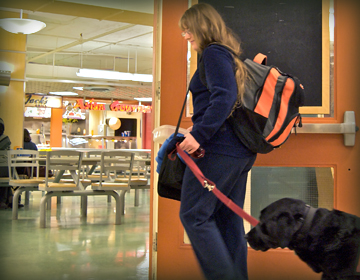

Practice: Serving People with Disabilities Practice 2 Peter approaches the woman and explains that health regulations restrict animals from entering the cafeteria. He suggests that, if she leaves the dog in the hallway, he would be happy to help her get lunch. Has Peter taken the right steps here? If you were in Peter's situation, what would you do? Click on one option below. After introducing himself and offering assistance, Peter tries to make the woman feel more welcome by greeting her guide dog and patting it on the head as they enter the cafeteria. Can you tell where Peter made a mistake in this situation? Click here to view the answer. If the woman accepts Peter`s offer of assistance, what should he do next? Click on the correct response. After receiving the feedback, click on the other option for more information. |
 |
| CC On | CC Off | Resources | Map | Back | Next | Audio Player: |
Practice: Serving People with Disabilities
Practice 2
Peter works in the college cafeteria. One day after the lunch rush, he is straightening chairs and tables when he sees a woman entering the cafeteria with her guide dog.
Peter approaches the woman and explains that health regulations restrict animals from entering the cafeteria. He suggests that, if she leaves the dog in the hallway, he would be happy to help her get lunch.
Has Peter taken the right steps here? If you were in Peter's situation, what would you do?
Click on one option below.
After introducing himself and offering assistance, Peter tries to make the woman feel more welcome by greeting her guide dog and patting it on the head as they enter the cafeteria.
Can you tell where Peter made a mistake in this situation?
If the woman accepts Peter`s offer of assistance, what should he do next?
Click on the correct response. After receiving the feedback, click on the other option for more information.
Yes, Peter has handled the situation properly. (click here to close this box)
Peter has not handled the situation well. Can you tell where he made mistakes?
When you approach a person with vision loss or other disabilities, first introduce yourself. Don't just start talking to the person without explaining who you are. Next, ask if you can assist the person – they will let you know how you can help.
But Peter made a more important mistake in this case. Can you identify the error?
A service animal cannot be refused entry even to a food service area. A person with a disability has the right to be accompanied by their service animal wherever they go.
No, Peter has not handled the situation properly. (click here to close this box)
You're right. Peter has not handled the situation well. But can you tell where he made mistakes?
When you approach a person with vision loss or other disabilities, first introduce yourself. Don't start talking to the person without explaining who you are. Then ask if you can assist the person – they will let you know how you can help...
More importantly. Peter should not refuse access to the guide dog. A service animal cannot be refused entry even into a food service area. A person with a disability has the right to be accompanied by their service animal wherever they go.
Can you tell where Peter made a mistake in this situation? (click here to close this box)
It is important not to make a fuss over the guide dog. Service animals are working animals and should never be distracted from their important job.
Take the woman's arm and guide her to a table. Once she is seated, offer to get her food. (click here to close this box)
When assisting a person with vision loss rather than taking her arm, offer your own arm for her to hold. Explain where you will be going and guide her at a reasonable pace.
Take her to the food service counter. Don't assume she can't get her own food. She will ask if she needs assistance carrying the food to her table.
Offer his arm for the woman to hold. Explain where they are going while he walks her and the guide dog to the food service counter. (click here to close this box)
This is the correct way to escort a client with a vision loss. Don't take her arm but rather offer your own arm for her to hold. Explain where you will be going and guide her at a reasonable pace. Never assume the person with the disability can't get their own food. They will tell you if they need assistance.